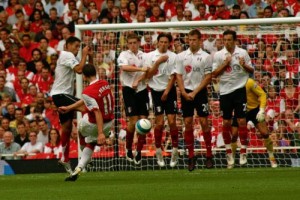Confused by Soccer Free Kicks? Let Our Guide Help You
You may have been watching a soccer game and then heard the referee blow his whistle to call for a foul. The ball will then be placed on the field and a team will be given a free kick from that spot. If you are wondering what is going on, then you have come to the right place.
There are 2 types of free kicks, a direct and an indirect free kick. To keep things simple, a direct free kick is the only one where the kicker can kick the ball directly into the goal. Read on to find out about when each of these free kicks will be awarded!
What Is a Direct Free Kick in Soccer?
A direct free kick will be given when a player is called for a foul. The kick will be taken by the opposite team from the spot where the foul took place and the ball must not be moving when the kick is taken. Also, the kicker is not allowed to touch the ball again until it has touched another player.
A direct free kick will be given when a player commits one of these fouls:
- Kicks or attempts to kick an opponent.
- Trips or attempts to trip an opponent.
- Jumps at an opponent.
- Charges an opponent.
- Strikes or attempts to strike an opponent.
- Pushes an opponent.
- Tackles an opponent.
- Holds an opponent.
- Spits at an opponent.
Additionally, if a player (other than the goalkeeper) touches the ball with their hands or arms intentionally, a direct free kick will be given.
What Is an Indirect Free Kick in Soccer?
An indirect free kick will be awarded when a player commits a non-penalty foul. The most common foul that results in this type of kick is when a player is called for being offside. It is named an indirect free kick because you must pass the ball to another player before you can kick the ball directly into the goal.
An indirect free kick will be also given when the goalkeeper commits one of these fouls:
- Touches the ball with their hands after releasing it from their possession, but before another player has touched it.
- Holds the ball for more than 6 seconds with their hands before releasing it.
- Touches the ball their hands after a teammate has purposely kicked it back to them.
- Touches the ball with their hands directly after a throw-in from a teammate.
A player can also commit these fouls that will result in an indirect free kick:
- If a player prevents the goalkeeper from releasing the ball from his hands.
- Plays in a dangerous way, such as kicking the ball in the air near the head of an opponent.
- Interferes in the movement of an opponent.
An indirect free kick is also taken from the spot where the penalty took place. Also, like the direct free kick, the ball must be motionless when the kick is taken and cannot be touched by the kicker until it has touched another player.
Can a Free Kick Be Awarded Inside the Penalty Box?
 Only an indirect free kick can be awarded inside the penalty box. When the goalkeeper is called for a foul in his penalty area, or an obstruction occurs then the indirect free kick will take place inside the penalty box. If a foul that would normally result in a direct free kick happens in the penalty area, then a penalty kick will be awarded.
Only an indirect free kick can be awarded inside the penalty box. When the goalkeeper is called for a foul in his penalty area, or an obstruction occurs then the indirect free kick will take place inside the penalty box. If a foul that would normally result in a direct free kick happens in the penalty area, then a penalty kick will be awarded.
Can Any Player Take a Free Kick?
Any active player on the field can take a free kick. In fact, a few goalkeepers have been able to score goals from direct free kicks. Check out this goalie showing off his skills:
What Is the Signal for an Indirect Free Kick?
For an indirect free kick, the referee will hold his arm up in the air. The referee will continue holding his arm in the air until the ball has been kicked and either touches another player or goes out of bounds.
What Is the Signal for a Direct Free Kick?
For a direct free kick, the referee will point his arm forward but does not need to hold it in that position until the kick is made.
